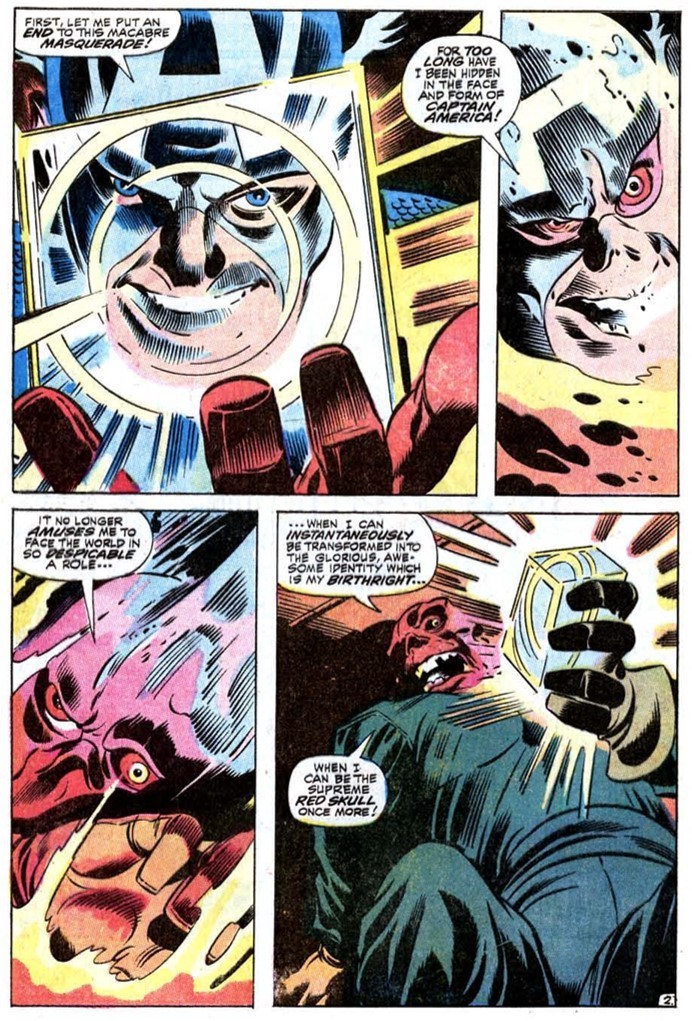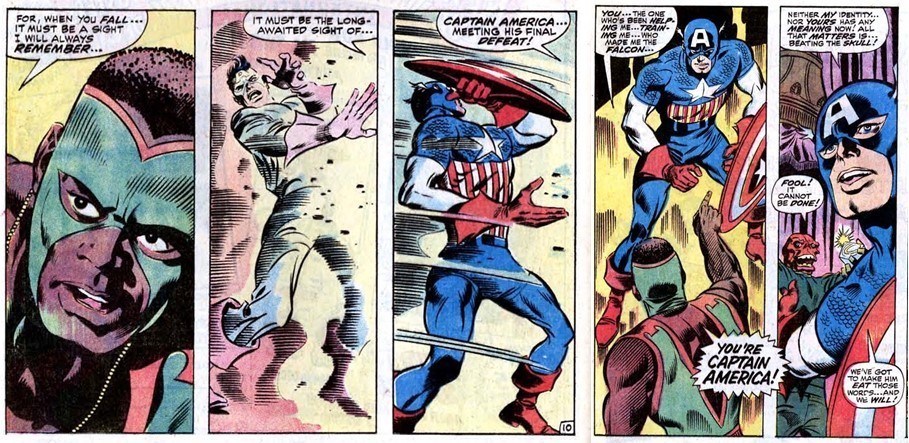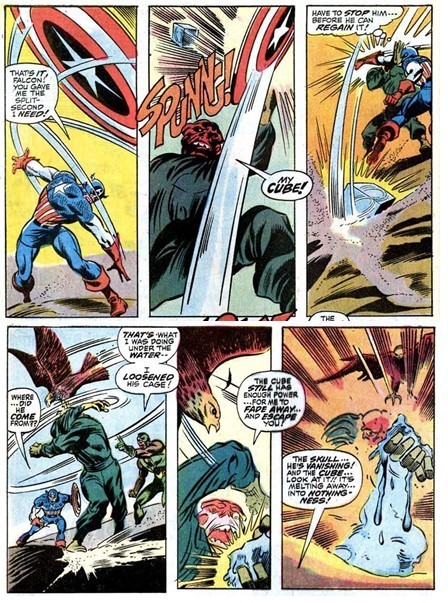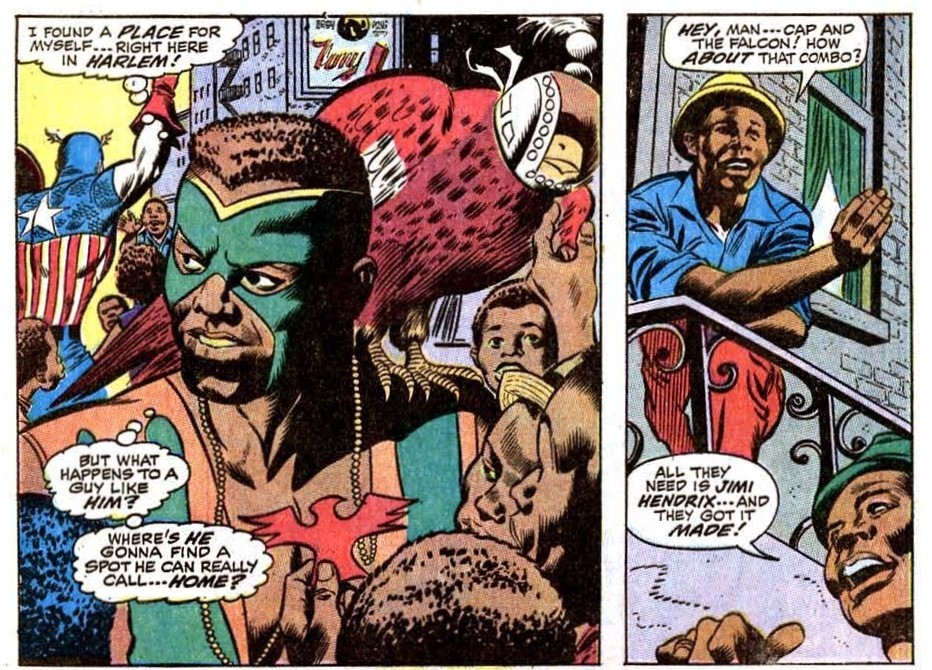A People’s History of the Marvel Universe, Week 15: Cap Meets the Falcon on the Isle of Forbidden Love

However, the very length of that outline speaks to the hubris of my initial idea. The reality is that Sam Wilson as a character is far too important to be covered in only one essay. Consider that Sam Wilson’s introduction led to the very title of the comic changing for 88 issues – or 47% of a Claremont – in a row. For more than seven years, then, Captain America was not a solo character but one part of a duo.

In this essay, I want to begin our examination of Sam Wilson’s role by, appropriately enough, starting from the beginning. The broader context and environment is crucial here, because Sam Wilson enters the narrative at one of the lowest points in Steve Rogers’ life: the Red Skull has regained possession of the Cosmic Cube (which is way more powerful than any mere Tesseract), which in this story functions as a cross between the literal Demiurge and an infinite wishes genie:

Captain America, being who he is, decides not to “pay homage to your acknowledged master” and instead chooses to fight God barehanded. As one might expect, this doesn’t go so well, but as with most existential struggles, the point is that Cap refuses to give in to an unjust God or to break when subjected to mind-bending Lovecraftian torture:

Like the top-quality supervillain he is, the Red Skull isn’t satisfied with the mere physical victory of flinging his opponent “a thousand dimensions away”[1] So in order to finally break Captain America’s indomitable spirit, he hits on the most terrifying torture known to man: identity theft.

For once, this strategy actually makes a lot of sense. As an inherently ideological hero, there is little that Captain America fears more than an attack on his reputation among his fellow citizens. The Red Skull’s Grand Theft Me plan threatens to weaponize that very bond with the common man, turning Cap into a vector for Nazi ideology. Making it all the worse is that Rogers can’t really fight back on the battlefield of public opinion while wearing the Red Skull’s face. (People who made it through Secret Empire will note that this Cap-turns-evil storyline is surprisingly familiar; I would argue that this version is way more meaningful on a psychological and political level than what Nick Spencer put together.)
However, the Red Skull is way too much of a vaudevillian villain to start with such a straightforward scheme. Instead, Schmidt’s initial plan is to force Sharon Carter to shoot her lover while Cap is trapped in the body of his hated enemy for maximum drama. (Not the last time that Steve and Sharon’s relationship will involve her pulling a gun on him under some form of “all-consuming compulsion.” If they ever go to a relationship counselor, that poor bastard has their work cut out for them.) In a twist that would surprise precisely no genre fan, the nigh-omnipotent Red Skull is foiled…by the power of love:

Outraged that he’s been defeated by the equivalent of the Care Bear Stare, the Red Skull banishes his body-swapped nemesis to a Caribbean island that has been conquered and colonized by his Nazi boy band, the Exiles, who are best known for outlawing love:


This is the context in which Steve Rogers meets Sam Wilson on the island of forbidden love: as far as he knows, he’s permanently trapped in the Red Skull’s body (for really stupid story reasons, it turns out that the titular cranium is “really just a mask,” allowing Steve to pass as a totally generic white dude, but with black hair) and will never be Captain America again, and suddenly he meets a freedom fighter seeking to liberate black people from Nazi oppression:


This meeting gives Cap a way out of his identity crisis: because he might not come back, either as Captain America or because he’s lowkey planning to die fighting God, he sees Sam Wilson as his replacement. (For his part, Sam Wilson’s relationship with Steve Rogers is permanently shaped by the fact that, virtually uniquely in the Marvel Universe, because of the body-swap, Sam got to know Steve Rogers the person before he met Captain America, the living legend.) Steve offers on the spot to train Sam to be a super-hero:


If all of this Grecian wrestling on the From Here to Eternity beach strikes you as a bit Tom o’ Finland, you’re not wrong. Whether intended or not, there is a robust queer subtext to Gene Colan’s pencils – from the “camera” angles and framing, to how Sidney Poitiers was the clear inspiration for the portraiture, to the composition of Sam’s frequently shirtless torso – that will only become richer in future installments of A People’s History of the Marvel Universe. Particularly significant for the purposes of this column is the fusion of the romantic with the ideological and super-heroic, as Steve and Sam’s relationship is forged in overthrowing a Nazi regime:

While Sam and Steve re-enact the Haitian Revolution, the Red Skull’s long con plan to destroy Cap’s reputation is undone by the fact that he can’t handle people liking him:

Once again, the Red Skull’s Nazi ideology – in this case, his anti-populist belief in social hierarchy (and no, it’s not an accident that Schmidt recoils from the admiration of a black family[2] and immediately begins reiterating his belief in the subordination of the masses by the master race) – proves to be his undoing, because he can’t deal with ordinary people. First, when Schmidt tries to ruin Cap’s reputation by making him look like a publicity-obsessed gloryhound, he freezes up when the free press asks him the mildest of questions:

Almost thirty years of experience in building doomsday devices and hiding out in volcano bases turns out not to be very good preparation for dealing with public relations. Second, the Red Skull is literally chased out of town by the sheer Beatles-like intensity of Cap’s fanbase:

Once again, the kids are all right. Foiled by a bunch of meddling kids, the Red Skull succumbs to a fit of villainous egoism and decides to use his godlike powers to revert the body-swap, thus giving Cap the ability to fight back:


And so where Cap failed on his own, Captain America and the Falcon unite against the psychological torment of the Cosmic Cube, using the power of teamwork – and some unseen assistance from M.O.D.O.K, who doesn’t like the Red Skull biting A.I.M’s style – to confuse and baffle the Red Skull until he bobbles the Cube and goes out like the Wicked Witch of the West:

And so, their friendship tempered in the heat of battle, Captain America and the Falcon are anointed as a superhero duo – with the Falcon, officially the first African-American superhero, declared the protector of Harlem and Steve continuing in his role the Man out of Time:

As
the presence of the crowd suggests, Captain America and the Falcon’s
partnership would be a way for Stan Lee and Gene Colan to Talk About Race in
America – for good and ill. But that’s a subject for the next People’s History of the Marvel Universe…
[1] Unsurprisingly, Stan Lee confuses dimensions with light-years or galaxies here.
[2] While Some Anvils Need to Be Dropped, there is a certain awkwardness that comes with two white creators dropping a black character into the narrative for the sole purpose of saying that Steve Rogers is “one man with soul.” One of the running themes of this and succeeding essays about Sam Wilson is going to be the more than occasional awkwardness that comes from two well-meaning white liberal dudes in their mid-to-late 40s opining on race relations in late 60s/early 70s America. See also in this story where Sam Wilson describes himself as a “big city brother” from the “swinging slums of Harlem.”
